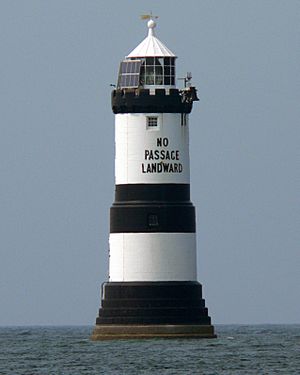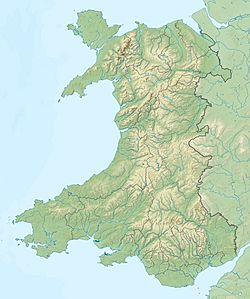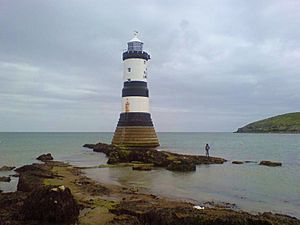Trwyn Du Lighthouse facts for kids
 |
|
| Trwyn Du Lighthouse | |
|
|
|
| Location | Penmon Anglesey Wales United Kingdom |
|---|---|
| Coordinates | 53°18′47″N 4°02′26″W / 53.312994°N 4.040630°W |
| Year first constructed | 1838 |
| Automated | 1922 |
| Construction | stone tower |
| Tower shape | cylindrical tower with balcony and lantern |
| Markings / pattern | white and black bands tower, white lantern |
| Height | 29 m (95 ft) |
| Focal height | 19 m (62 ft) |
| Current lens | 1st Order catadioptric fixed |
| Intensity | 3,088 candela |
| Range | 12 nmi (22 km) |
| Characteristic | Fl W 5s. |
| Fog signal | bell stroke once every 30s. |
| Admiralty number | A5140 |
| NGA number | 5420 |
| ARLHS number | WAL-031 |
The Trwyn Du Lighthouse, also called Penmon Lighthouse, is a famous lighthouse in Wales. It stands between Black Point near Penmon and Puffin Island. This lighthouse helps ships navigate safely. It marks the path between these two islands, located at the eastern tip of Anglesey.
Contents
Building the Lighthouse
The first lighthouse here was built in 1838. It cost about £11,589 to construct. Sailors from the nearby city of Liverpool had asked for a light in this spot for many years. This was especially true after a ship called the Rothsay Castle crashed in 1831. About 130 people lost their lives in that accident.
Design and Features
The lighthouse you see today was built between 1835 and 1838. It is 29 metres (95 feet) tall. The famous engineer James Walker designed it. This was his first lighthouse built in the sea. It was a test for his even bigger lighthouse design on the Smalls.
The lighthouse has a special stepped base. This design helps to stop big waves from crashing too hard against the tower. It reduces the power of the water at the bottom. The walls are straight and simple, unlike other lighthouses. This was likely done to save money.
The tower has a stone parapet at the top, like a castle wall. It gets narrower as it goes up. These features were used by Walker in his other lighthouse designs too. The lighthouse is easy to spot because it has three black bands painted on a white background. It also says "NO PASSAGE LANDWARD" on its north and south sides.
Early Technology
James Walker also tried to add a special drain system. This was meant to be a basic water closet for the lighthouse keepers. However, strong waves often made it hard to use during bad weather.
The first light source was a special lamp with four wicks. It used a first-order fixed catadioptric optic. This part was made by Isaac Cookson & Co. The light shone a steady red color. One of the many lighthouse keepers was Joseph Steer, who was born in 1831.
Modern Lighthouse Operations
In 1922, Trwyn Du became the first lighthouse managed by Trinity House to be automated. This meant it no longer needed people to live there. It was changed to use acetylene gas, which could run without constant watching.
Recent Upgrades
The lamp was changed to use solar power in 1996. The lighthouse was also updated a lot at that time. Today, the lighthouse has a bright light that flashes once every 5 seconds. It can be seen up to 12 nautical miles (22 km) away.
There is also a fog bell that weighs 178 kilograms (392 pounds). This bell rings once every thirty seconds when it is foggy. There used to be a lifeboat station nearby, built in 1832, but it closed in 1915. The lighthouse has been unmanned since 1922. It is checked remotely from the Holyhead Control Centre. In 2019, Trinity House started testing a new fog horn. They said the old bell's electronic system was not reliable enough anymore.
Visiting the Lighthouse
You can visit Penmon Point by driving east from Beaumaris and through Llangoed. You can pay a small fee to drive very close to the lighthouse and park. Or, you can park for free about a mile away. The area around Dinmor has a cafe, a shop, and toilets. It is also a good spot for fishing.
Images for kids
See also
 In Spanish: Faro de Trwyn Du para niños
In Spanish: Faro de Trwyn Du para niños




